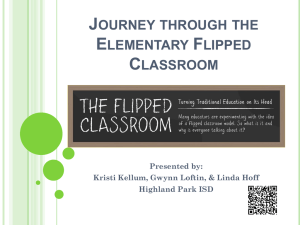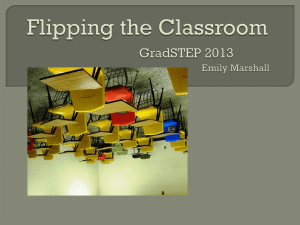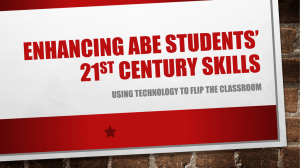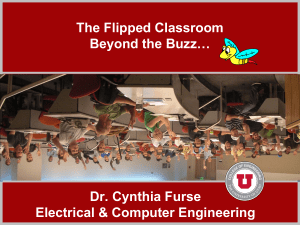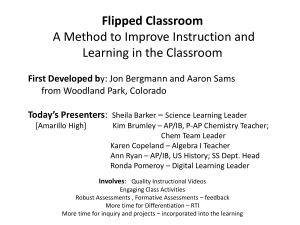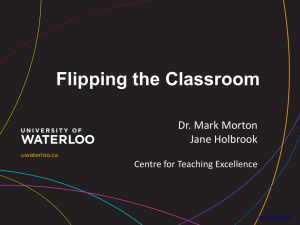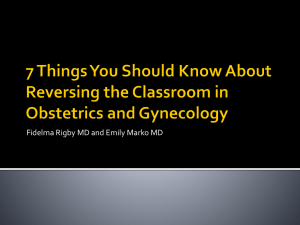Flipping Your Library Instruction
advertisement
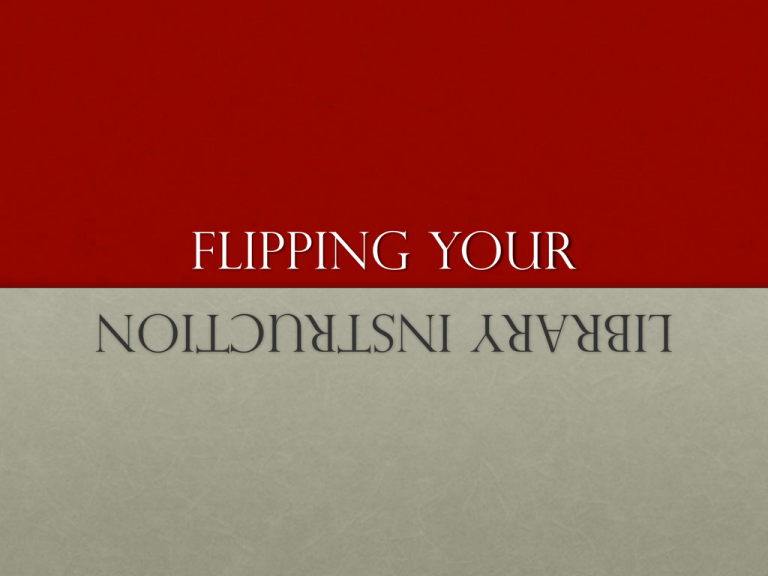
LIBRARY INSTRUCTION Flipping Your WHAT IS THE FLIPPED CLASSROOM? How is this USEFUL to ME? definition The flipped classroom is a pedagogical model in which the typical lecture and homework elements of a course are reversed.1 Short instructional videos are viewed by students before class Class time is used to apply knowledge students obtain from the videos Assessment is conducted through demonstration of successfully applied knowledge or short quizzes The Originators Johnathan Bergmann and Aaron Sams, science teachers at Woodland Park High School in Colorado, are considered the originators of the Flipped classroom.2 Here’s their video Benefits of the flipped classroom • Students are able to watch recorded lectures/tutorials any time, any place • Students are able to review the material as many times as necessary to understand the content without frantic notetaking • Different learning styles can be better accommodated by instructors and applied by students • Instructors are able to devote class time to the application of skills instead of “telling” students the information • Collaborative activities can be better designed to further peer teaching • Students have an opportunity to ask questions during application rather than after class or from graded feedback How do I use this? “Traditional” library instruction varies between institutions of higher ed, different types of libraries, and even different disciplines. Some of the types of library instruction include: One-shot library instruction sessions College-wide course in basic info literacy One-on-one instruction sessions with faculty and students Self-paced online tutorials Online library instruction course (with/without credit) A mixture of the above SHIFTING GEARS We’ll focus on the one-shot library instruction session for a minute. HERE IS HOW I FEEL ABOUT TRADITIONAL LIBRARY INSTRUCTION. SO WHAT DO I DO ABOUT IT WHAT IF… …The professor assigned students recorded library tutorials as homework prior to the instruction session …The students were able to watch and rewind the library tutorials prior to class …The class was able to jump right in with no navigational or background instruction …The students and instructor could spend time on targeted, specific instruction such as constructing searches or requesting materials WE GO FROM HERE… Photograph from the University of Iowa Libraries TO HERe. Photograph from Lawrence Berkeley Nat'l Lab - Roy Kaltschmidt, photographer Students watch the lectures before class… In class… • Instructor covers any questions from student-viewed recorded lectures • Students can form small groups or work individually • Students work on in-class activities • Students will apply the knowledge directly from instruction in the video • Instructor “mediates the activity,” does not lecture “AT” the students • Assessment is conducted through peer-review or short quizzes Perceived Challenges • Faculty buy-in • Faculty may not be open to a different pedagogical method of teaching • Faculty may be unwilling to assign out-of-class material for instruction sessions • Student resistance • Students may be resistant to completing video assignments • Students may not be at their “point of need” • MONEY – who has any? • ‘Cause if your library has some, I’ll take it Biggest challenge TIME THESE LESSONS TAKE YOUR TIME TO PREPARE. MORE TIME THAN THE ONE-SHOT INSTRUCTION SESSION THAT YOU ALREADY HAVE MEMORIZED. BIGGEST BENEFITs for library instruction • Library instruction recorded lectures can be made available in all the different library instruction settings (one-shot, selfpaced, subject-specific, college-wide course). • Once the videos are recorded, they can be used for multiple sessions. Only updates are required. • Students can access the materials at their point of need through your institution’s LMS. • The flipped classroom method of teaching gives the responsibility for learning back to the students, not the instructor Sounds great, but I’ve never done this… ??????? Here’s an example • Prior to the instruction session, the professor gives the students an assignment: • Watch the video Introduction to the Curry Library Website. • Read Chapter 3 of Research Strategies by William Badke: “Database Searching with Keywords and Hierarchies.” • Watch the video tutorial How to Plan Your Search Strategy. • Do the exercises at the end of Chapter 3 using the Curry Library ProQuest Central database. In class • Less in-class lecture, more in-class active learning activities. • Librarian acts as facilitator for student learning • Feedback and assessment can be a short quiz or graded worksheet Best practices • There are some basic tenets that have emerged as “best practices” in the flipped classroom: • Keep videos between 3 and 5 minutes long, no longer • Students are more receptive when the instructor is the one recording the video • Mix it up – do not just use all videos to flip your instruction, include other forms of multimedia, activities, and resources • Have a back-up plan for gaps in access to technology within the student body • Keep the technology you use for implementation as simple as possible. If it can go wrong, it will. The future? The Future of Flipped Classrooms • Flipped classroom methodology is being actively explored in all disciplines and levels of education • Technology has expanded the number of tools, many free, to facilitate active learning and peer collaboration • Flipped classroom pedagogy is currently being widely debated • Is this a better method to deliver library instruction? Just a different one? Not a method that fits your needs? Why not try it and see? notes 1. Educause Learning Initiative. "7 Things You Should Know About Flipped Classrooms." Educause Library, 2012. http://www.educause.edu/library/resources/7-things-you-should-know-aboutflipped-classrooms. 2. Hamdan et al., “A Review of Flipped Learning.” Flipped Learning Network, 2013. http://www.flippedlearning.org/cms/lib07/VA01923112/Centricity/Domain/41/ LitReview_FlippedLearning.pdf bibliography Benjes-Small, Candice and Katelyn Tucker. “Keeping Up With…Flipped Classrooms.” ACRL, 2013. http://www.ala.org/acrl/publications/keeping_up_with/flipped_classrooms Bishop, Jacob Lowell and Matthew A. Verleger. “The Flipped Classroom: A Survey of the Research.” 120th ASEE Annual Conference, Atlanta, GA, June 2013. http://faculty.up.edu/vandegri/FacDev/Papers/Research_Flipped_Classroom.pdf Herreid, Clyde Freeman and Nancy A. Schiller. “Case Studies and the Flipped Classroom.” Journal of College Science Teaching 42, no. 5 (2013). http://capone.mtsu.edu/vjm/Univ_Service/CRWG_Home/References/CRWG-CHEM-REF05.pdf Miller, Andrew. “Five Best Practices for the Flipped Classroom.” Edutopia, February 2012. http://www.edutopia.org/blog/flipped-classroom-best-practices-andrew-miller Roehl, Amy, Shweta Linga Reddy and Gayla Jett Shannon. “The Flipped Classroom: An Opportunity to Engage Millennial Students Through Active Learning Strategies. Journal of Family & Consumer Sciences 105 no. 2 (2013). http://search.proquest.com/docview/1426052585?accountid=15047 contact Rebecca Hamlett Curry Library William Jewell College Liberty, MO hamlettr@william.jewell.edu
